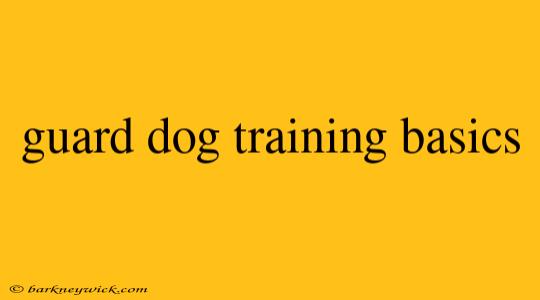Guard Dog Training Basics: Protecting Your Home and Loved Ones
The idea of having a loyal and protective companion watching over your home and family is appealing to many. But turning your furry friend into a reliable guard dog requires more than just a bark and a wag of the tail. It involves a well-planned training program that fosters protective instincts while ensuring safety and responsible behavior.
My personal experience with guard dog training
I've always been drawn to the idea of having a dog that could deter unwanted visitors and provide a sense of security. So, when I adopted my German Shepherd, Luna, I knew I wanted to explore the possibility of training her for guard dog duties. It wasn't about aggression or intimidation, but about teaching her to alert us to potential threats and act as a strong deterrent.
This journey taught me that effective guard dog training is a delicate balance. It's about building a strong bond with your dog, teaching them to recognize and respond to specific cues, and instilling confidence without encouraging unnecessary aggression.
The importance of a balanced approach
In my opinion, the most important aspect of guard dog training is finding a balance between protective instincts and responsible behavior. A well-trained guard dog should be obedient and under control, not a fear-inducing threat.
Here's where the objective content comes in:
- Breed selection: Not all dog breeds are suitable for guard dog training. Certain breeds like German Shepherds, Rottweilers, Doberman Pinschers, and Great Danes have natural protective instincts and are often preferred for this purpose. However, the breed alone doesn't guarantee success.
- Early socialization: Socialization is crucial for any dog, but especially for guard dogs. Exposing your puppy to different people, places, and situations from an early age helps them develop a balanced temperament and avoid unnecessary fear or aggression.
- Professional guidance: It's highly recommended to seek the guidance of a professional dog trainer specializing in guard dog training. They can help you assess your dog's temperament, develop a tailored training program, and ensure you're equipped to manage their behavior effectively.
Helpful Tips for Training Your Guard Dog:
- Basic obedience: A strong foundation in basic obedience commands like "sit", "stay", and "come" is essential for any guard dog. This allows you to control their behavior and ensure they respond to your commands, even in stressful situations.
- Territory awareness: Start by familiarizing your dog with their territory, teaching them to recognize the boundaries of your property. This can involve walking them around the perimeter and rewarding them for staying close.
- Alerting and deterrence: Train your dog to bark or alert you to the presence of strangers approaching the property. Use specific commands like "guard" or "alert" and reward them for their response.
- Controlled aggression: Avoid using punishment or force-based training. Instead, focus on positive reinforcement and rewarding desirable behaviors.
- Socialization and desensitization: Regularly introduce your dog to new people and situations, under your supervision. This helps them develop a balanced temperament and reduces the likelihood of overreacting to strangers.
A note on entities:
It's important to mention reputable entities like the American Kennel Club (AKC), which offers valuable resources and guidelines on responsible dog training and breeding.
Conclusion:
My journey with Luna taught me that guard dog training is a rewarding experience, but it's also a responsibility. It's about creating a protective partnership that ensures the safety of your family while fostering a well-behaved and obedient companion. Remember, a well-trained guard dog is an asset, not a liability, and its effectiveness depends on a balanced approach that prioritizes both safety and control.
